How to Plan an Amazing Algarve Itinerary (3-7 Days)
Planning a trip to the Algarve, the gorgeous coastal paradise along the southern edge of Portugal? Lucky you! You’re in for a treat full of pristine beaches, crystal-clear turquoise water, and charming small towns dotting Portugal’s southern coast.
In this guide to planning an Algarve itinerary, we’re going to use our experience spending a week on the Algarve to help you plan the perfect Algarve trip.
The Algarve was the last stop on our three month European adventure, which had us arriving in southern Portugal at the end of November. We organized it that way because we knew that the Algarve was a safe haven from the cooler, grayer weather that would be descending on the rest of Europe at that time of year, and we were absolutely correct.
The entire stretch of Portugal’s southern stretch from Sagres to Tavira is covered in a combination of beautiful beaches, coastal bluffs, and towering limestone cliffs that are practically begging to be explored. It’s also just a really, really pleasant place to relax on the beach with a book, or to get out on the water and do some surfing or kayaking.
In this detailed guide to planning your trip to the Algarve, we’re going to go through the logistics you need to know to make the most of your time and avoid headaches, and a detailed 4 day Algarve road trip itinerary that takes you to some of our favorite spots from our trip.
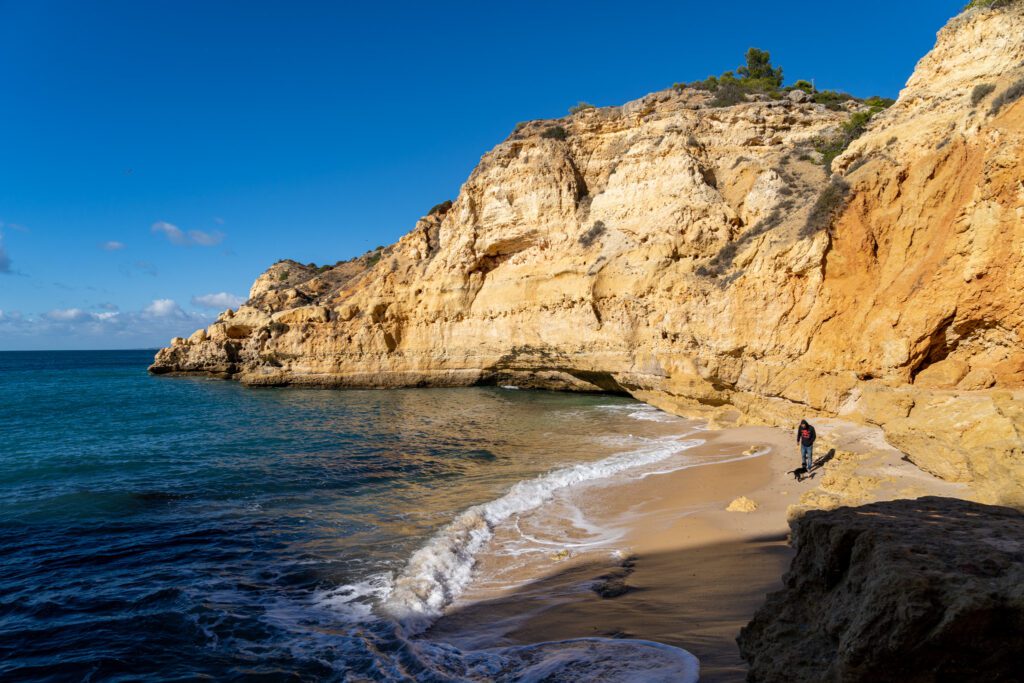
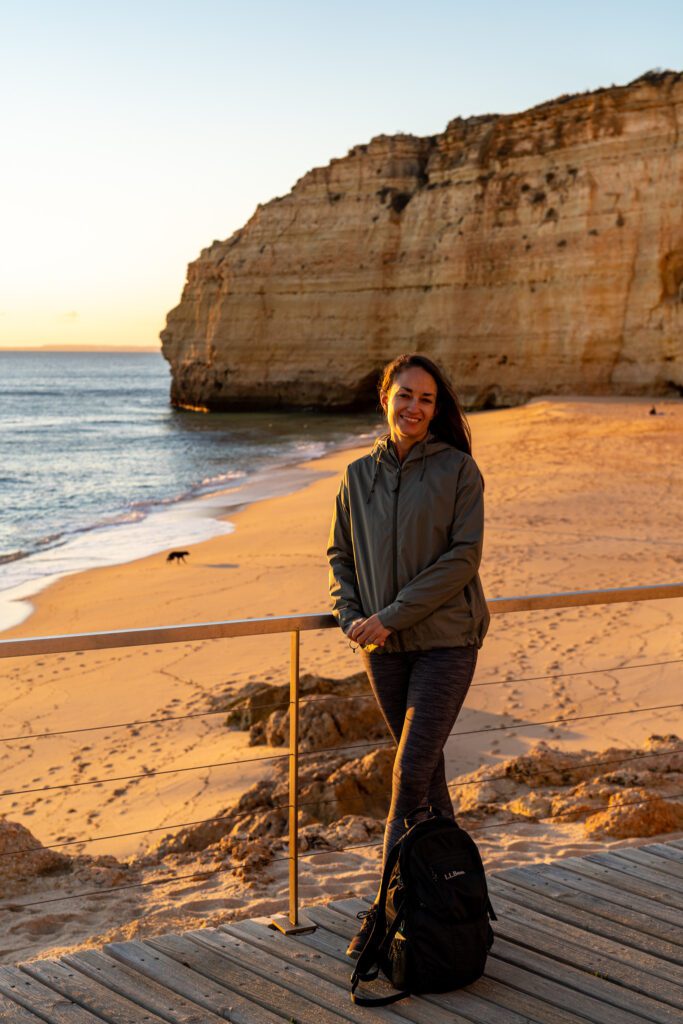
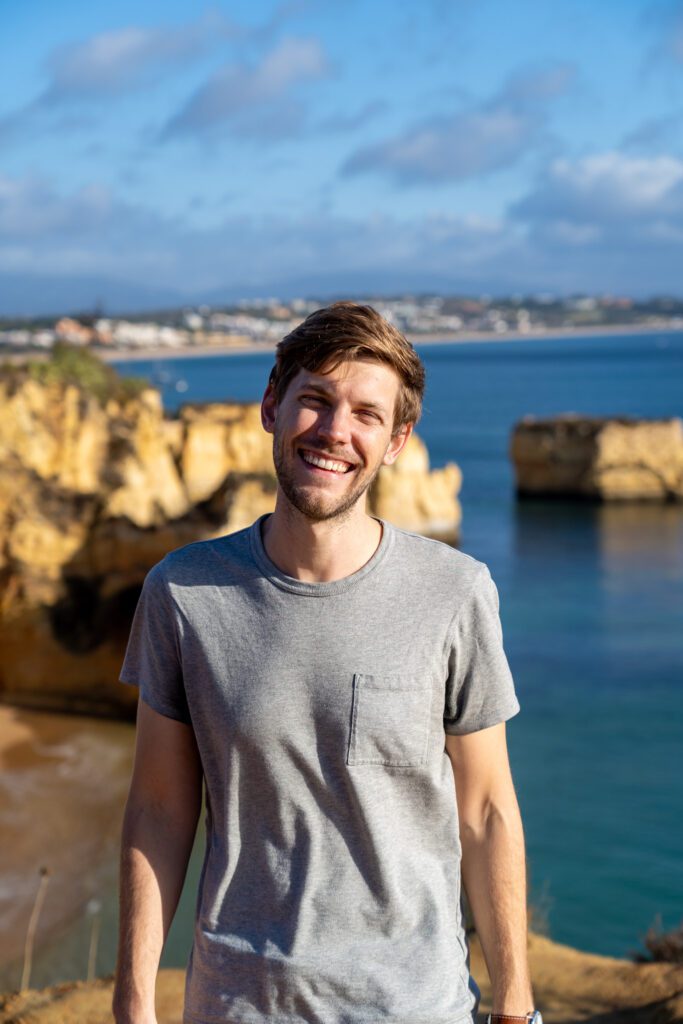
Disclaimer: Some of the links in this post, like hotel links, are affiliate links, meaning at no additional cost to you, we make a little bit of money if you click through and book. That being said, we would never recommend something to you that we don’t stand behind 100%.
How Much Time Do You Need on the Algarve?
In short, it depends on what you’re looking for.
Here’s the long version.
The longer you have, the more relaxed your trip will be. You’ll have more time to lounge on the beach, drive along the coast, and stop for whatever else catches your interest.
With a shorter visit to the Algarve, you’re going to be hitting the highlights without too much time to slow down and relax, which is the best part about the Algarve, in our opinion.
It’s a great addition to the other places you’ll visit on a Portugal itinerary – Lisbon, Porto, and other cities – because the pace is slower, and there aren’t any traditional “sightseeing” sights to see.
3 days on the Algarve gives you enough time to drive out to Sagres, a charming surf town at Europe’s southwest corner, explore the area around Lagos, and walk the Seven Hanging Valleys Trail and explore its beautiful beaches.
4 days on the Algarve, which is what we’ve written this guide for, gives you a bit more time. You’ll do the things we mentioned above, but you’ll also be able to rent a kayak and head out to the Benagil Caves, and explore the eastern Algarve’s beaches.
A full week on the Algarve gives you plenty of time to split between activities and relaxing on the beach. If you’re looking for a more relaxing beach holiday, 7 days on the Algarve is a good choice.
If the Algarve is a part of a broader Portugal itinerary, we’d recommend between 3 and 5 days.
Where to Stay in the Algarve
Before we talk specifics, let’s quickly step back and think about “strategy,” for lack of a better word.
You have a couple of choices in terms of your approach to staying in the Algarve.
At one end of the spectrum, you could stay in a different place every single night, moving around, packing and repacking every day, and experiencing a bunch of different towns and cities.
If there’s anything we learned on our three month trip around Europe, it’s that packing SUCKS. So we’d recommend avoiding it as much as possible.
On the other end of the spectrum is staying in a single place for your entire stay. You’ll have the benefit of not having to worry about check-in times or packing your stuff multiple times, but you might have to do more driving.
If you have four days or more, we’d recommend splitting your time between two places to get the best of both worlds.
Choose one place in the western Algarve, between Lagos and Sagres, and one place further east, around Carvoeiro. This will give you two different experiences, cut down on driving, and not add too much repacking.
Want more details on which towns to choose? We have an entire guide breaking down five great places to stay in the Algarve that you should read.
Which Towns on the Algarve Should You Stay in?
Now that we’ve talked strategy, let’s talk specifics. We chose Lagos and Carvoeiro as our two home bases, and really enjoyed both for different reasons.
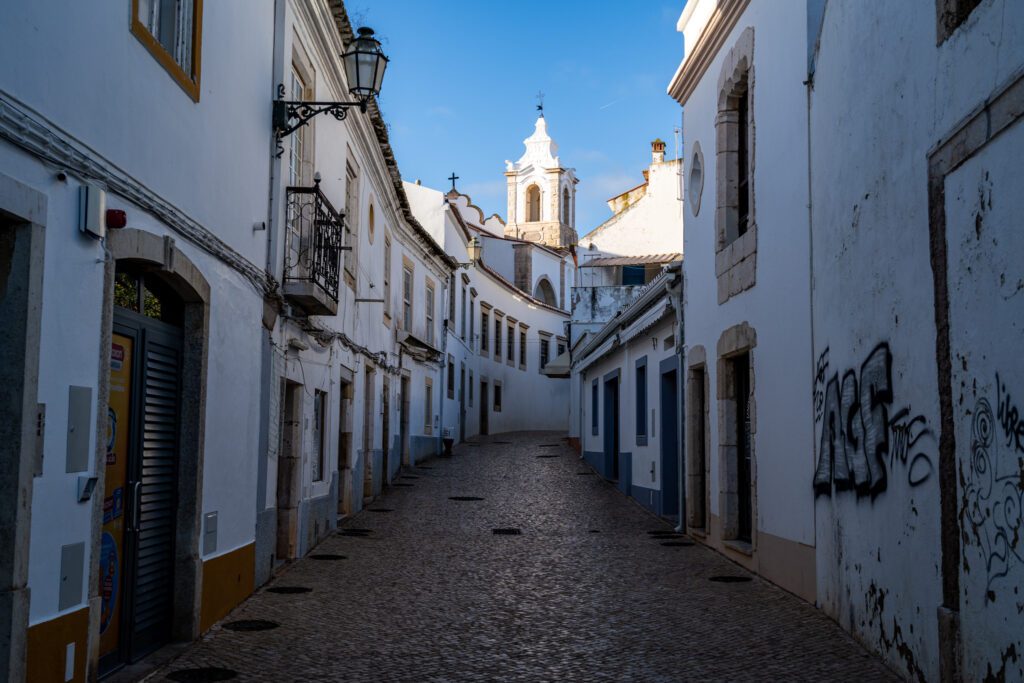
Lagos is a more developed city that sees a huge influx of tourists every summer.
The old town is charming, with plenty of bars, restaurants, cafes, and shops to choose from, all within walking distance of most of the places to stay. It’s lively and buzzing, so don’t expect a quiet stay if you’re here in the summer.
In Lagos, we stayed at The Salty Lodge, an apart-hotel with spacious apartments that had everything we needed for our stay, including a full kitchen.
If you’re looking for something quieter than Lagos, look at the sleepy fishing village of Salema, about 20 minutes west.
If you’re looking to spend your time surfing, look at staying in Sagres, which is very much a surftown.
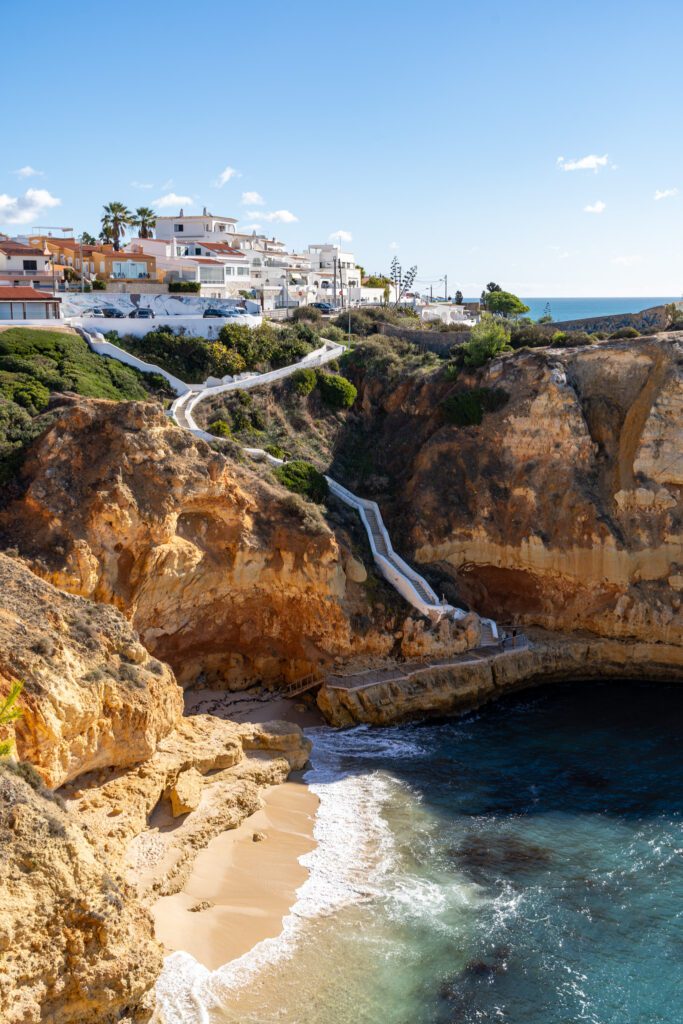
Carvoeiro has a very different vibe than Lagos. It’s more low-key and residential, though the small downtown area near the beach has a nice selection of places to eat and drink.
The draw here is the location, which is central to a bunch of amazing beaches and stretches of coastline to explore.
We enjoyed relaxing on our deck at Hello Villas, which is a nice complex of townhouse style one and two bedroom units that we stayed in.
If you’re looking for a smaller, more charming town on this beautiful stretch of coast, look at Alvor, or Ferragudo.
Getting Around the Algarve
After traveling by train and bus for part of our trip to the Algarve, and then renting a car for the second part, we have a strong perspective that the best way to enjoy the Algarve is by renting a car.
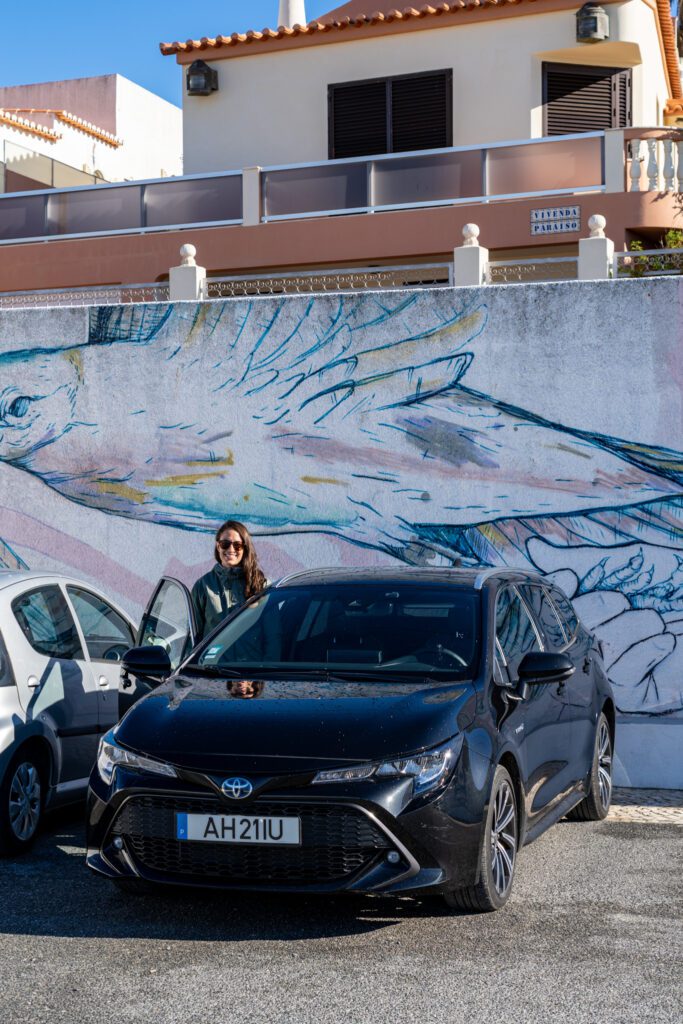
Sure, there is a regional train network that connects the major towns on the Algarve, but oftentimes the best beaches are going to be a bit outside of town, and a car makes it easier to get there.
It will give you more flexibility, since trains aren’t that plentiful (they only come a few times a day) and it’s hard to figure out exactly when local and regional buses come (or if they come at all).
Tips for Renting a Car in Portugal
We think you should definitely rent a car, it’s just a matter of figuring out the best way to do it for your particular trip.
Here are a few things to consider about renting a car in Portugal that we discovered over the course of our trip.
- If you’re picking up a rental car in one place and dropping it in a different place, your rental will be subject to a “one-way” fee that escalates based on the distances between locations. For reference, we picked up our car in Lagos and dropped it in Évora, which is about a three hour drive, and it was a 50 Euro fee. We imagine the fee would be similar for Lisbon.
- There is an airport surcharge of about 30 Euros, depending on the company, that applies when you are either picking up or dropping off at an airport (in this case, likely either Lisbon Airport or the Faro Airport). You could avoid this by picking up the car in Lagos instead, but if you are arriving at the Faro Airport, it makes more logistical sense to just pay the fee.
- Always always always rent a car through trusted multinational corporations like Avis, Hertz, and Europcar. To be completely honest, this basically goes against everything we believe about traveling (supporting local companies, mainly), but we recommend avoiding renting a car through local companies, who are usually more likely to nickel and dime you half to death. Trust us on this one.
We rented a car twice during our three month European adventure, once in Sicily, once on the Algarve.
Both times we used AutoEurope to compare prices with different rental companies and find the best rates, and booked a car through Europcar, which was a pleasant experience both times. We’d recommend both.
A Note on Toll Roads in Portugal
There are toll roads on the Algarve (and throughout Portugal), which means you will pay to use the bigger, faster highways. The two you’re most likely to encounter are the A2 between Lisbon and the Algarve, and the A22 between Lagos and Faro.
You have three options.
- Pay the tolls in cash as you drive or at the local post office if it’s an electronic toll road (don’t do this one, it seems super inconvenient to have to track down a post office at least 48 hours after using the toll road).
- Pay a couple of Euros a day for a transponder through the rental car company (this is our recommendation and is what we did just in case we needed it, though we managed to avoid all toll roads).
- Avoid using toll roads altogether and spend an extra 10-20 minutes on the road (we used the “avoid tolls” setting in Google Maps).
More information on toll roads in Portugal here.
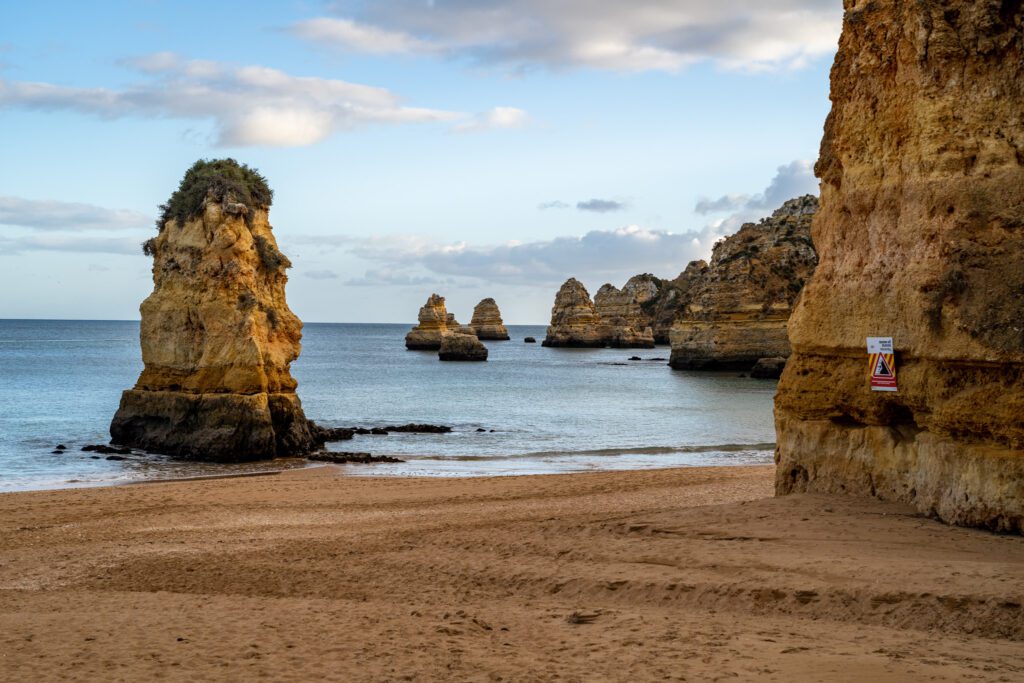
A 4 Day Algarve Itinerary: Planning the Perfect Algarve Road Trip
Now that we’ve covered the important logistics you’ll need to know to plan your trip, let’s get into exactly what to do on the Algarve.
Day 1: Lagos and Around
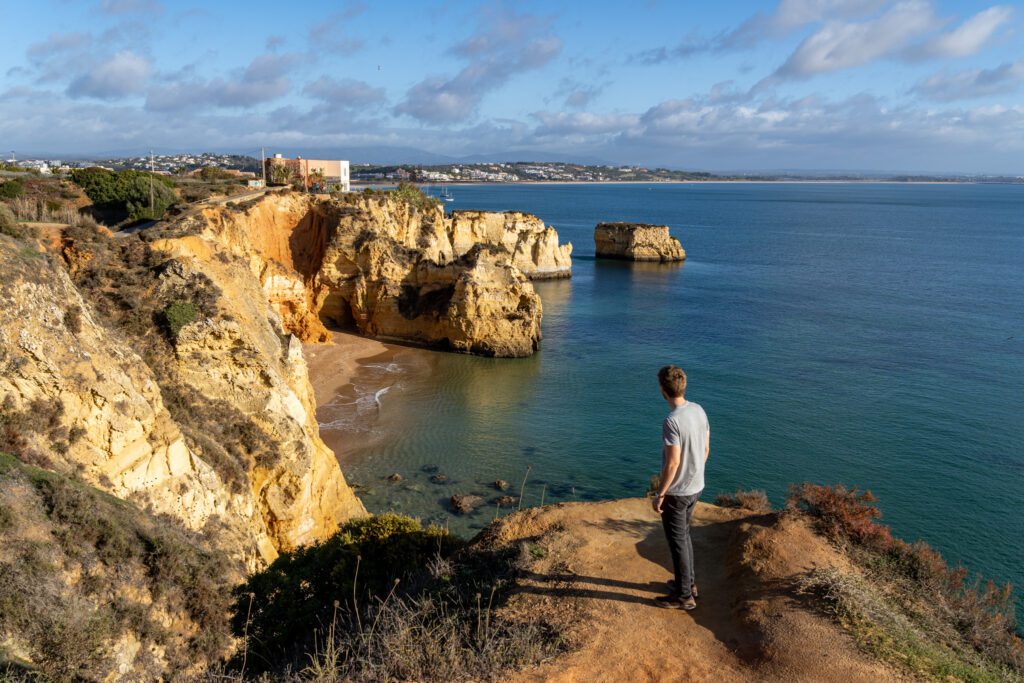
On your first day, settle in and explore the area around Lagos. There are some amazing beaches within walking distance of the center of Lagos, which is a bustling little beach town with lots of bars and restaurants (many of them catering overtly to tourists).
A little further out, there are some beaches that are more easily accessible with a car.
We’re assuming that it will take most of the morning to get to Lagos from wherever you’re arriving from, so consider this a half day.
Walk from Lagos to Praia dos Estudantes and Praia da Dona Ana
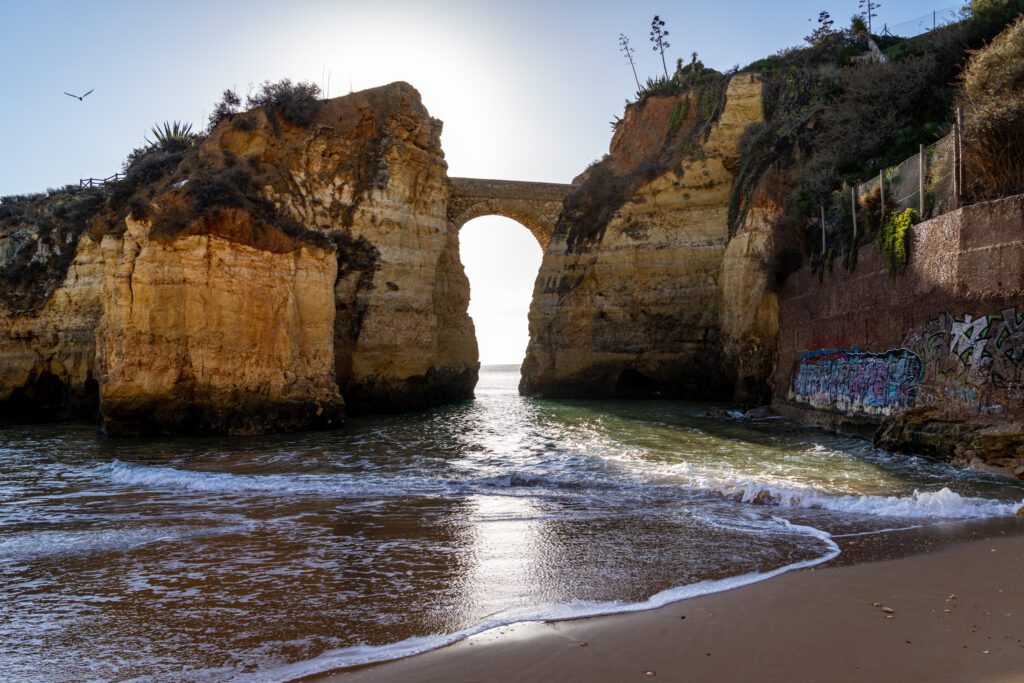
Two of our favorite beaches on the entire stretch of coast between Sagres and Tavira were within walking distance of Lagos.
The first, Praia dos Estudantes, is one of the Algarve’s most famous beaches thanks to the Roman bridge that is visible from the beach.
Next, stop by Praia do Pinhão, where you can pick up a coastal route up on the bluffs that takes you to the third beach on your tour-de-Lagos-beaches.
The last beach, Praia da Dona Ana, is also one of the most-visited beaches in the entire region. It’s a little cove, accessible from both ends, and the best views of the beach are from the bluffs on the eastern side (which is where you’ll find yourself if you follow the coastal trail).
All three beaches would be a good spot to relax in the sun for a few hours. Make sure to bring sunscreen and plenty of water.
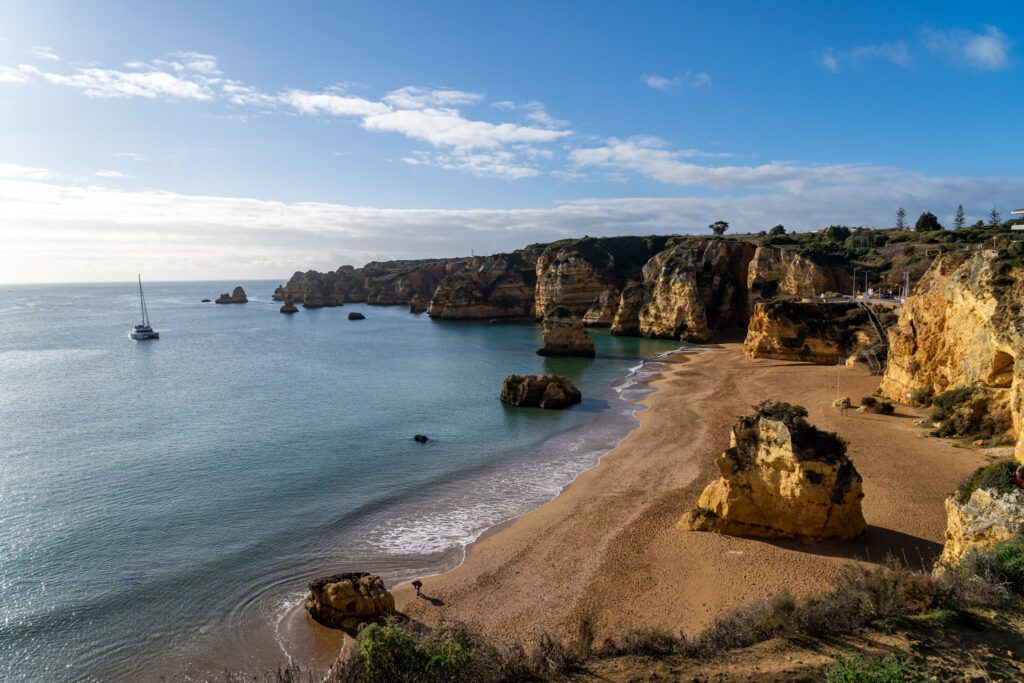
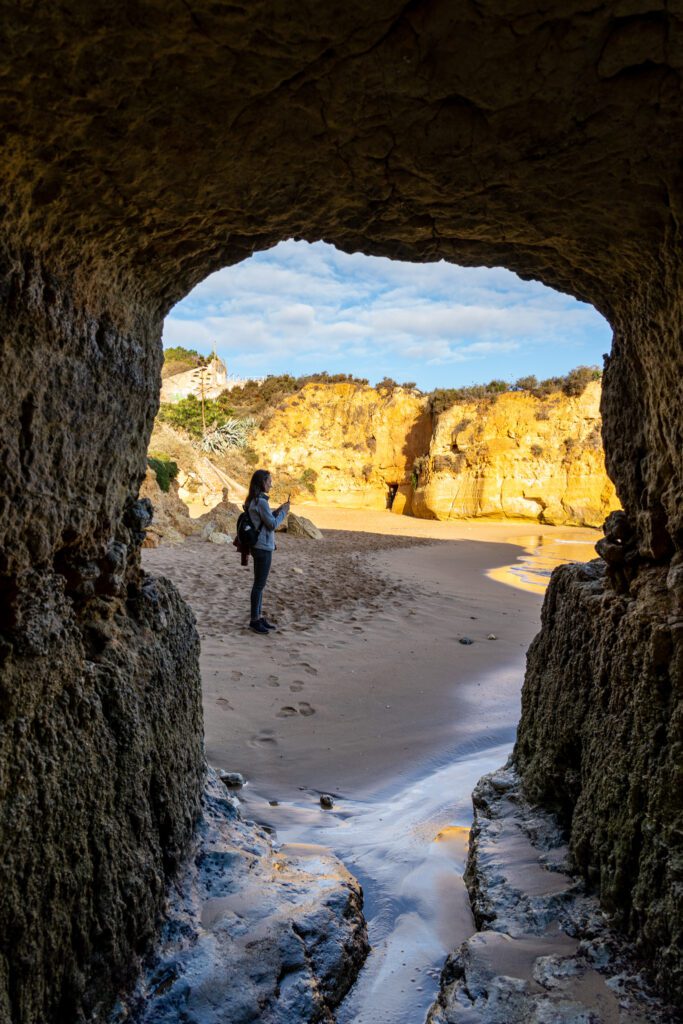
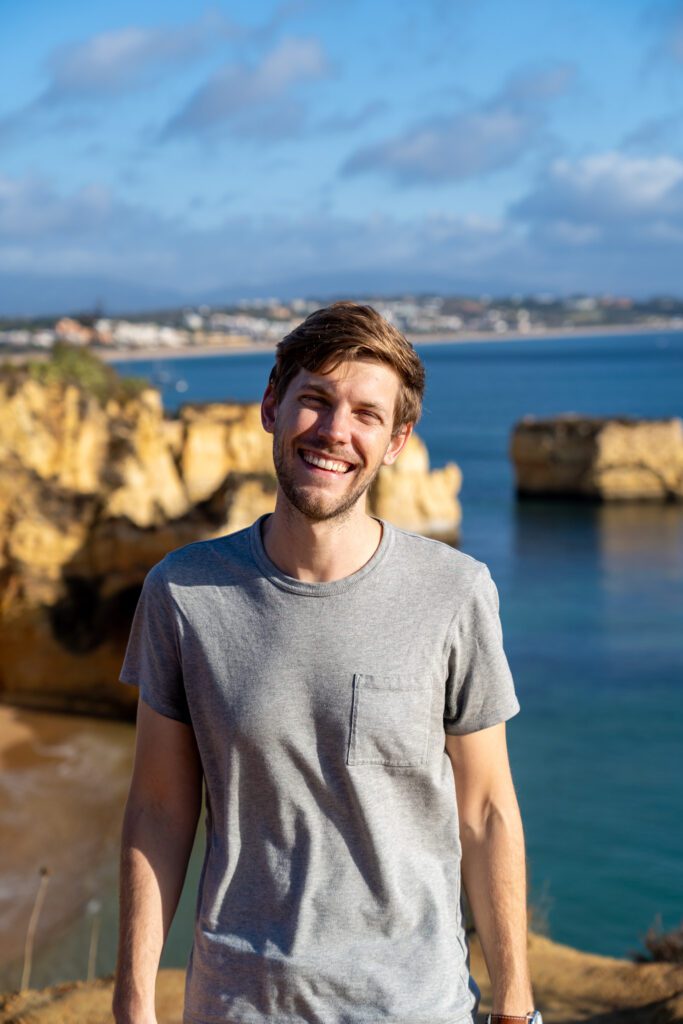
Go to Lunch at Restaurante Chico Zé
For seafood that’s about as fresh as it can be, head out to Restaurante Chico Zé, which is a 10 minute drive north of the center of Lagos.
It’s a family run, lunch-only establishment where there is almost always a line out the door during the high season (and sometimes during shoulder seasons). Don’t miss the grilled sardines, served with potatoes.
They also have a rotating selection of other grilled fishes and meats. Not a place for vegetarians – barely a vegetable in sight!
An alternative closer to town would be Tasca Da Lota, which is within walking distance of the city center near the train station. It’s cash only.
End the Day at Ponta da Piedade
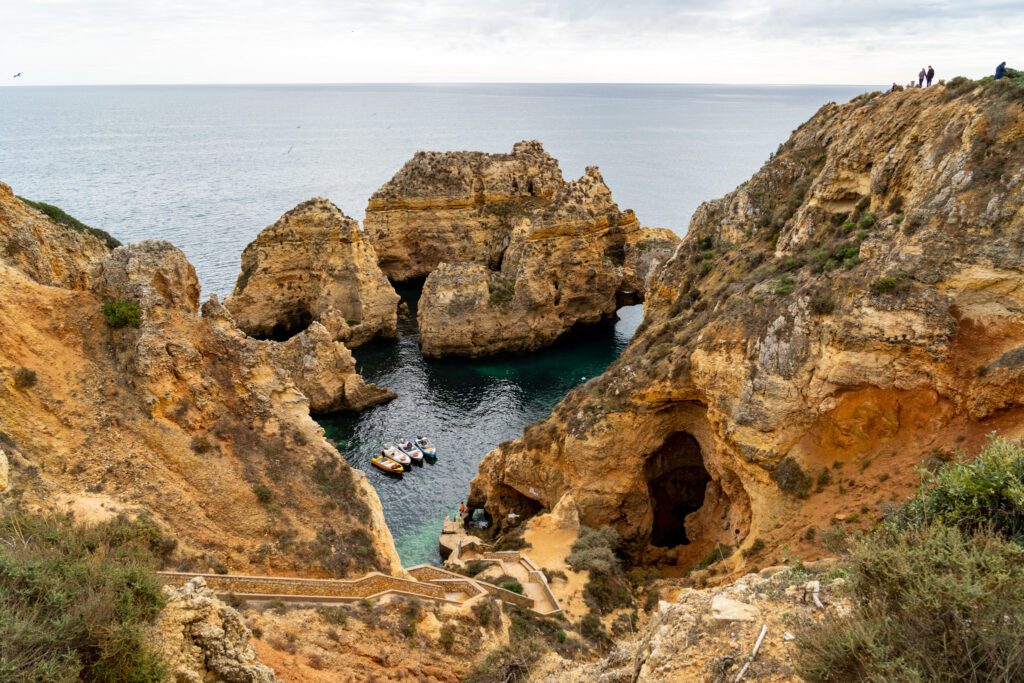
For sunset, drive out to Ponta da Piedade, which is a unique rock formation surrounded by sheer cliffs. It’s a spot that most of the boat tours leaving from Lagos stop at because there’s a series of cool sea caves and hidden grottos.
On foot, you can walk down the long set of stairs to get to the base of the cliffs – just remember that you’ll have to climb back up. Once you’ve done that, it’s also worth finding the trail that heads west from the parking lot and walking along the boardwalks for more amazing coastal views.
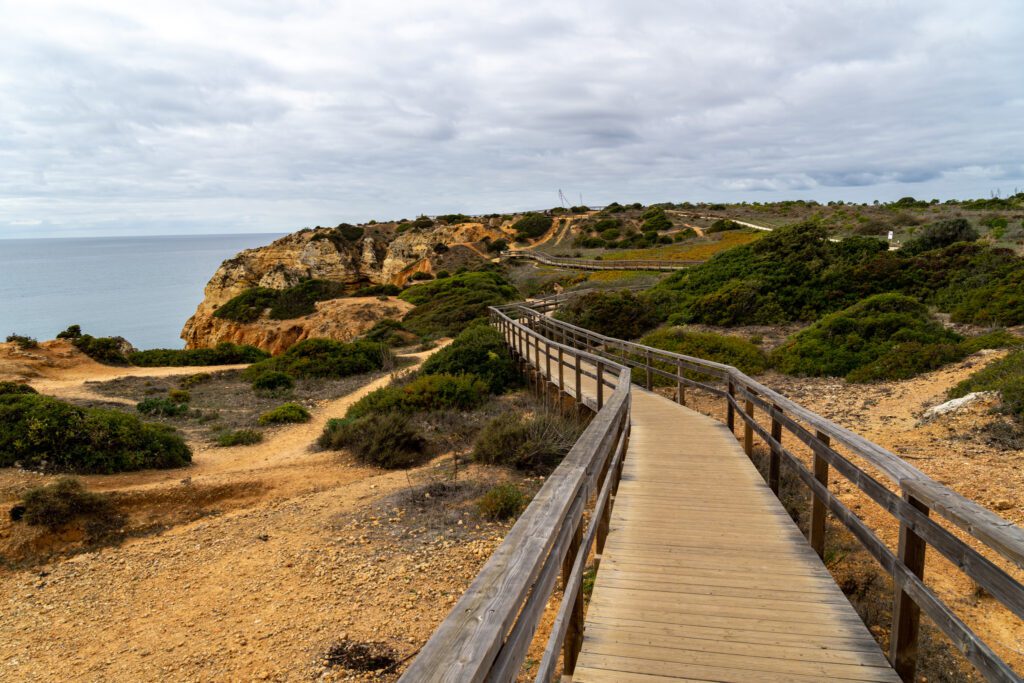
On the way, stop by Praia do Camilo, a small, hidden beach accessible only by climbing down a long set of steep stairs (and, again, climbing back up when you’re done, of course).
It should be mentioned that you can absolutely connect the beaches close to Lagos with Ponta da Piedade by hiking along the coastal bluffs, but it’s a long walk.
Day 2: Sagres and the Western Algarve
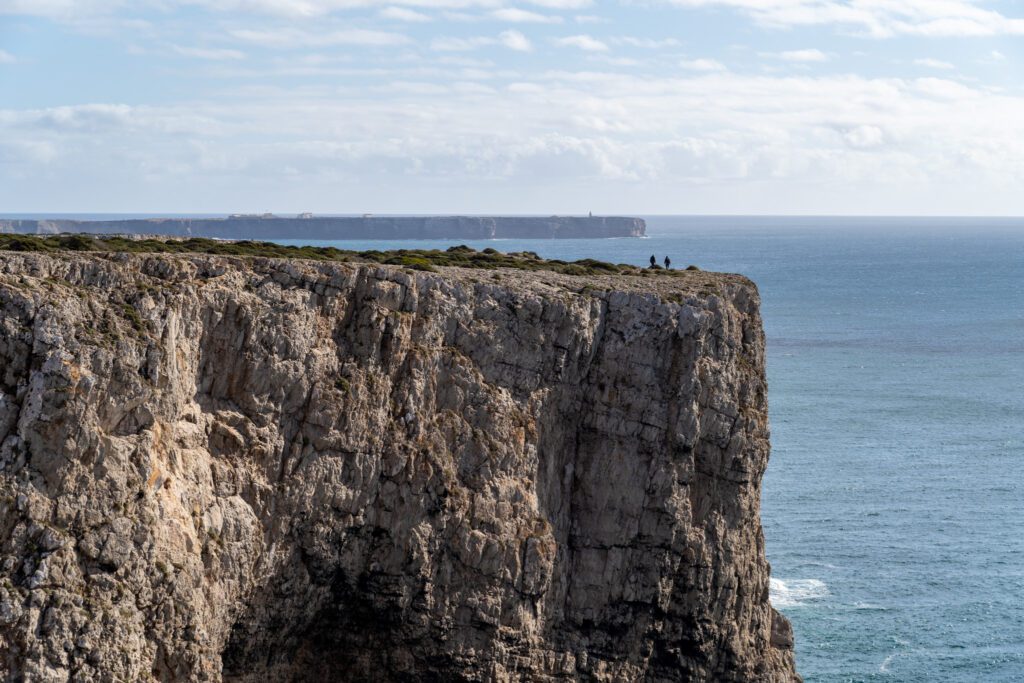
On your second day, head out to explore the windswept coast to the west of Lagos, eventually making it to the furthest point to the southwest in Europe.
Sagres is a sleepy little surf town, at least when we were there in the early winter when only the most committed surfers were in town.
We’d start by driving all the way out to Farol do Cabo de São Vicente, the southwestern-most point in Europe, and making your way back east towards Lagos.
Farol do Cabo de São Vicente
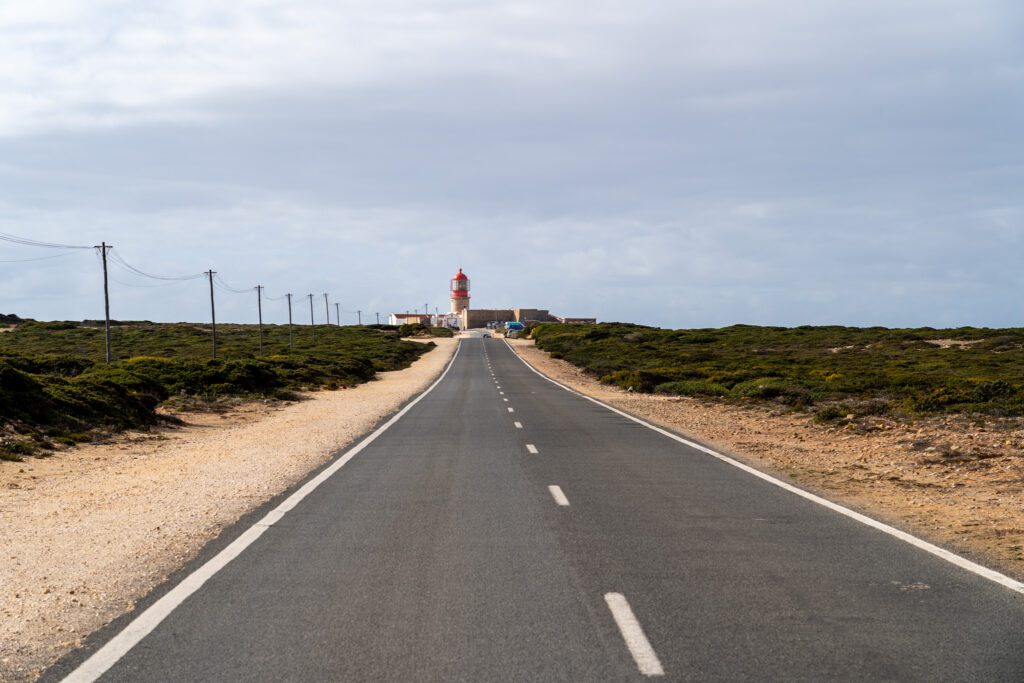
First of all, this entire stretch of coast reminds us of the stretch near where Alysha grew up in California – Point Reyes National Seashore. This lighthouse in particular, along with the picturesque cliffs it’s perched on, are reminiscent of the Point Reyes Lighthouse.
It’s beautiful, but there’s really not a whole lot to do or see here. It’s mostly a spot to admire the views and to say you have visited the furthest southwestern point in Europe.
Praia do Beliche
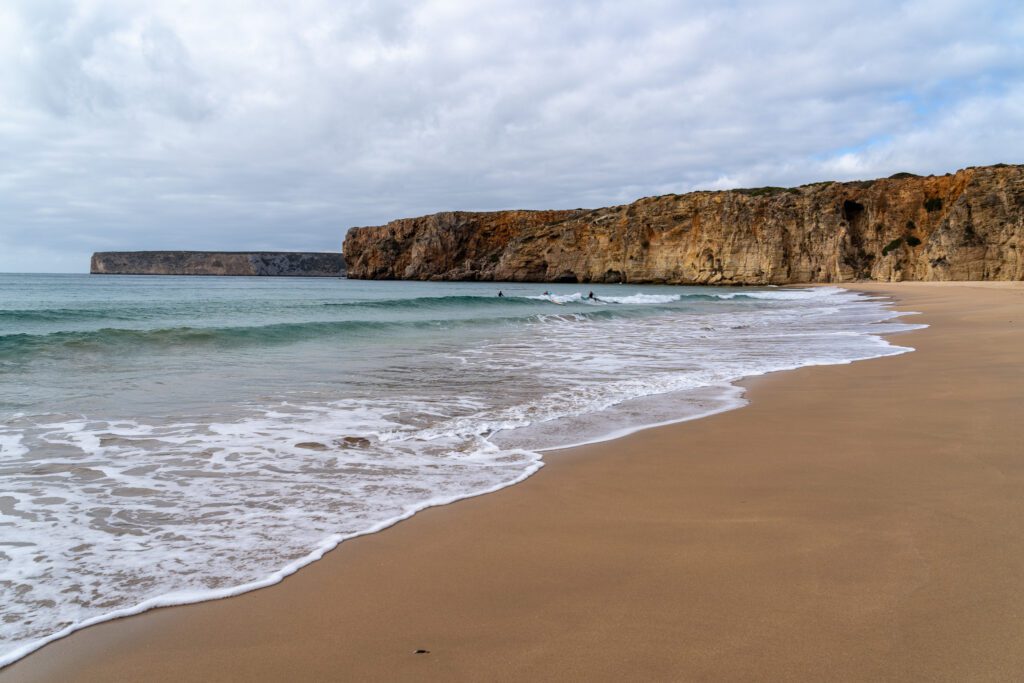
The stairs leading down to Praia do Beliche are not for the faint of heart. Most of the stairs in Portugal, whether they’re leading up to a church bell tower or down to a hidden beach, are steep. These are a whole other level.
As we drove up, we noticed that, despite the fact that it was kind of a blustery and cold day (the blustery part is true of basically every day in Sagres, which is notoriously windy), the parking lot was full of campervans with surfboards and wetsuits strewn about.
Keep in mind, this is the last few days of November, which means the water is likely very, very cold. Hard pass from us.
The beach itself is lovely, and because of the distance from the main cities on the Algarve, it’s relatively quiet compared to the beaches near Lagos.
It’s one of the best surfing destinations in all of Europe, so if you’re into surfing (or are looking to learn), this beach should be on your list.
The Town of Sagres
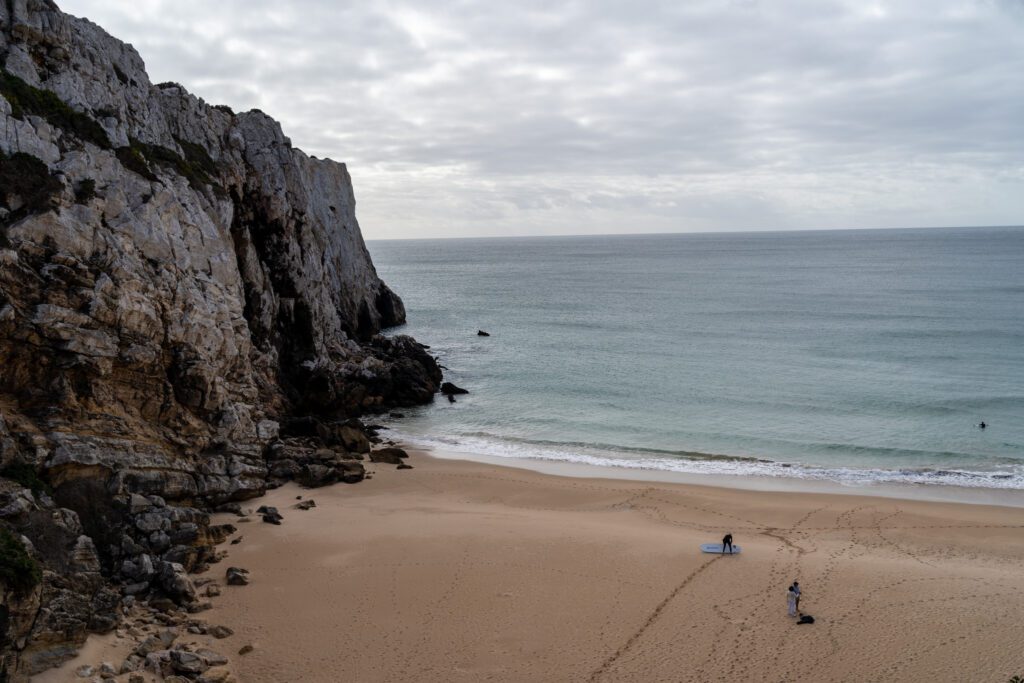
The town of Sagres is, well, tiny. There’s not a whole lot going on, and it has very “surf town” vibes. It’s a small town, and was very sleepy when we were around in November.
It’s worth heading out to the Fortaleza de Sagres, which you’ll have to pay a few Euros to access, but the views from the point are worth it. It is going to be windy when you’re there – it almost always is.
We liked Praia da Mareta (here on Google Maps) too, a wide, sandy beach with cliffs on either end.
It’s one of the better swimming beaches because it’s protected by those cliffs, and it’s not too busy even in the summer season. Praia do Martinhal (here on Google Maps) is another nice beach just a few minutes east of Sagres.
To get there, you drive back out on the main highway you took into town, then take a winding road down to the beach (we took a wrong turn and found ourselves in the housing development that looks suspiciously like a retirement community in Florida).
From here, you have a couple of options, and it depends on your appetite for more beaches and pristine coastline.
- Head back to Lagos and take a well-earned siesta before finding a place to have dinner and drinks.
- Drive north along the coast to Praia da Arrifana (here on Google Maps), another great beach that will give you a nice taste of Portugal’s Atlantic Coast. There are plenty of other beaches in the area, but a lot of them are on questionable dirt roads that your rental car may not like so much. Praia da Amoreira (here on Google Maps) is also worth a stop as it’s just north of the first beach and has a good road leading to the northern end of the beach.
- Head back to Lagos, but make a quick detour to Salema, a quiet fishing village with a wide, sandy beach where literally not a single place was open on the afternoon we were there. We’d imagine that changes drastically in the high season.
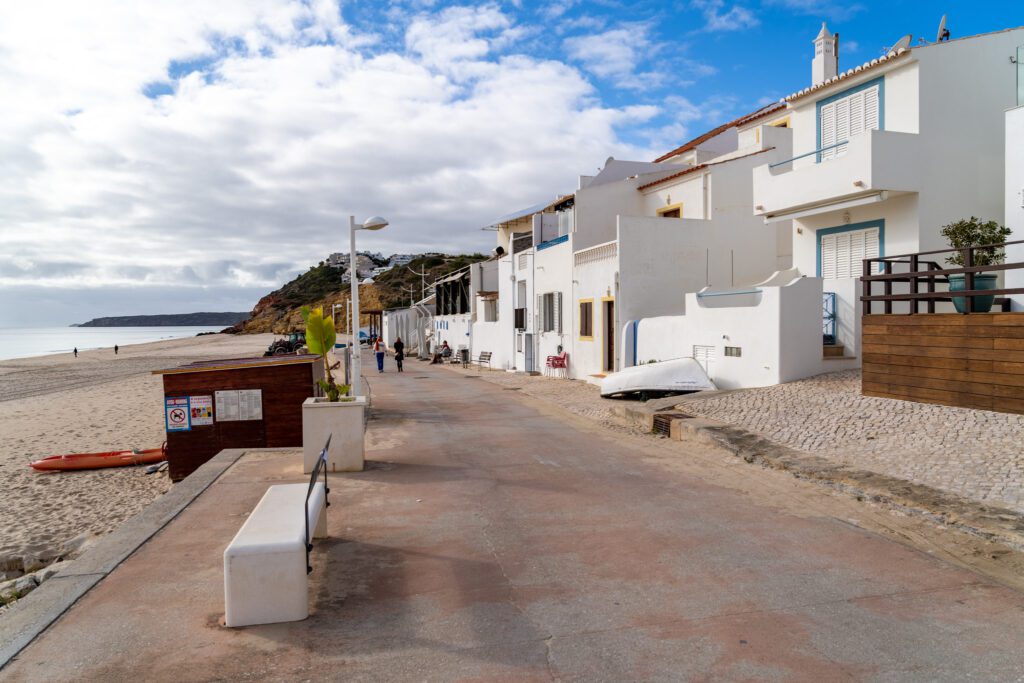
Day 3: The Seven Hanging Valleys Trail
On your third day, move to your second home base and hike the best trail in southern Portugal – the Seven Hanging Valleys Trail.
The Seven Hanging Valleys Trail
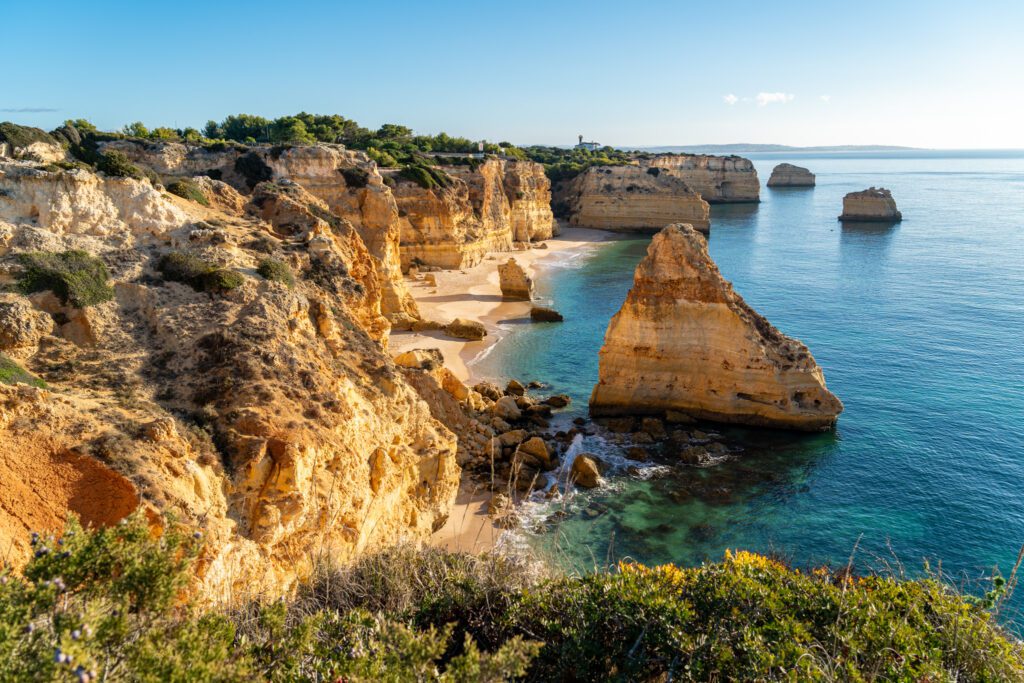
This hike, best done from east to west starting from Praia da Marinha to Praia do Vale de Centeanes, was one of our favorite experiences in Portugal. And we’re from coastal California, which we learned is very similar to the Algarve in terms of scenery, flora, and fauna.
The point is, it’s a great hike, and that’s coming from two people who have done countless hikes with similar views and scenery.
First, an overview of the full out-and-back hike.
- Length: 7 miles / 11.4 km (shorter versions below)
- Elevation Gain: 1,200 ft. / 365 meters
- Season: Year round
- Trail Type: Out and Back (we have ideas on alternate routes below)
- Difficulty: Easy / Moderate
- Trailhead Location: Either Praia da Marinha or Praia do Vale de Centeanes
- Dog Friendly: Yes!
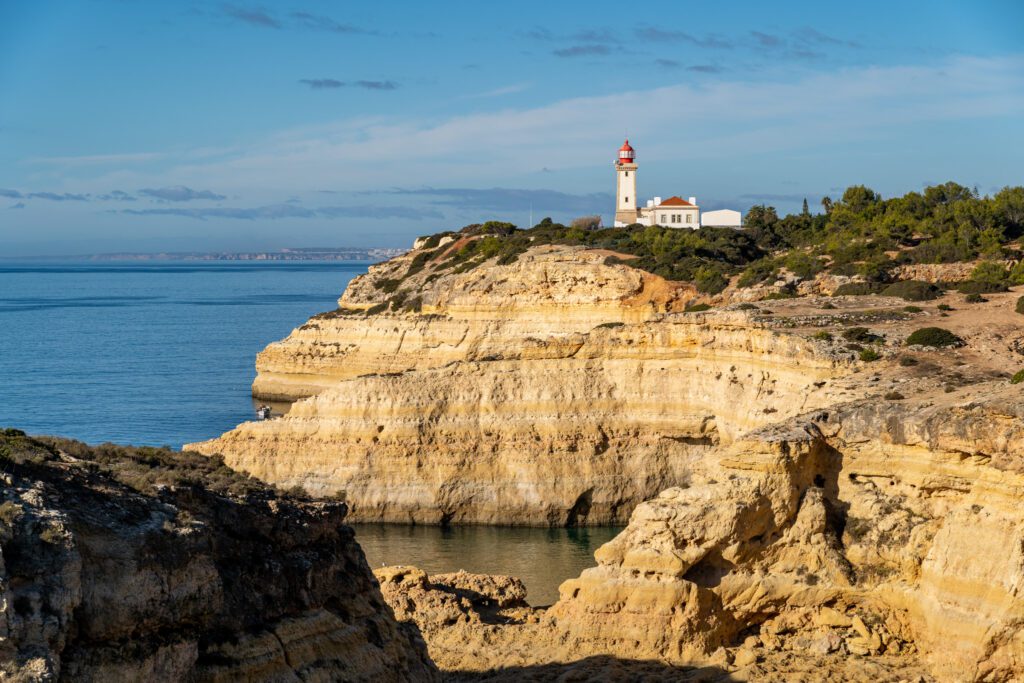
If that sounds like too much for you, you have a few options in terms of shortening the hike.
- Option 1: The Full Hike, Round Trip – 7 miles / 1,200 feet of elevation gain (11.4 km / 365 m). Hike the entire trail out-and-back from Praia da Marinha to Praia do Vale de Centeanes, and then back the way you came.
- Option 2: The Full Hike, One Way – 3.5 miles / 600 feet of elevation gain (6 km / 180 m). Do the entire hike, but only one way. This requires using either taxis, Uber, or hitching a ride to get back to your car at the first trailhead (or finding a way to get there without a car).
- Option 3: Partial Hike, Out and Back – 3.3 miles / 600 feet of elevation gain (5.6 km / 180 m). Hike the section between Praia da Marinha and Praia do Carvalho, which in our opinion is the best part of the trail. You can continue on to the nice lighthouse – Farol de Alfanzina, for an additional 2 miles (3.2 km) added to your round-trip distance.
If you’re attempting this hike in the summer, you should plan on being either a) on the trail hiking by 8:00 am at the latest, with plenty of water and sunscreen for the journey or b) absolutely miserable hiking through the heat of the day. Seriously, get an early start.
If you’re interested in doing the entire thing, you should head over and read our Seven Hanging Valleys Trail Guide, which has more details that will help you tackle it safely and have a great experience.
Sunset at Praia do Vale de Centeanes
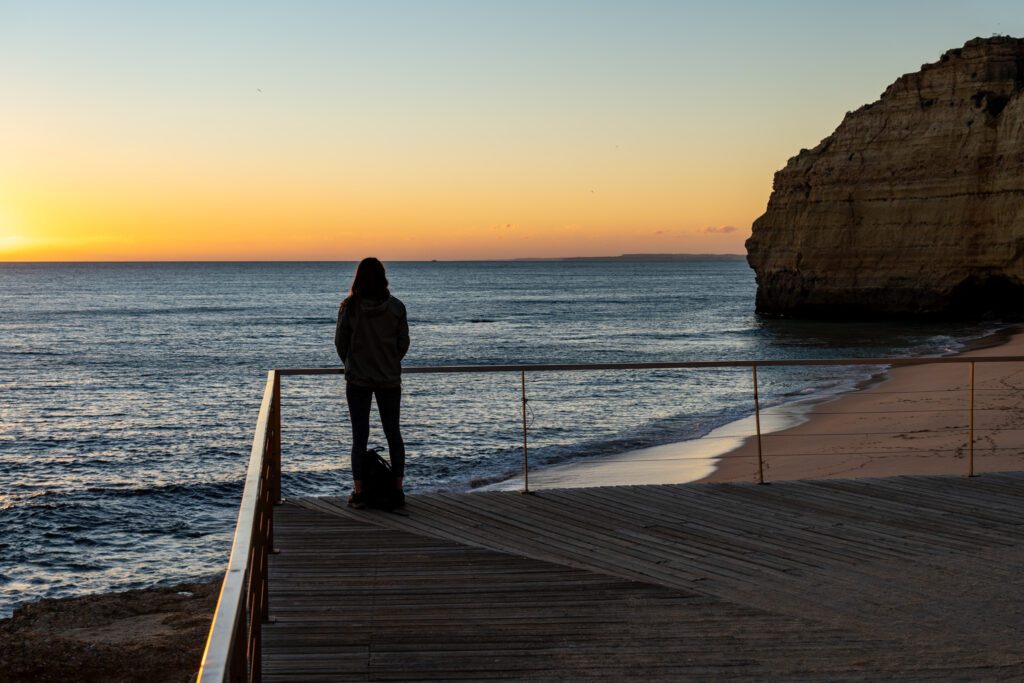
End your day at the ending point for the trail you hiked earlier in the day, which is a pretty spectacular place to watch the sunset.
Either head down to the beach, where you’ll be able to sit in the golden sand and watch the sun dip below the horizon line, or walk back up onto the bluff on the east side of the beach (where you came down on the hike) and walk out to the point, where there are a bunch of benches to sit on facing west.
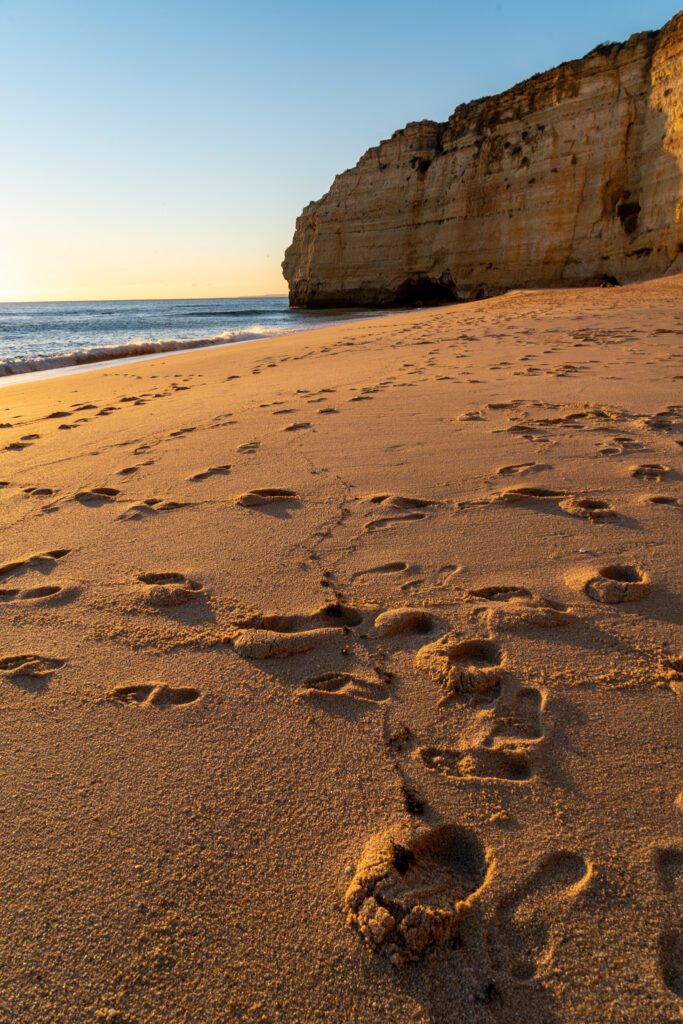
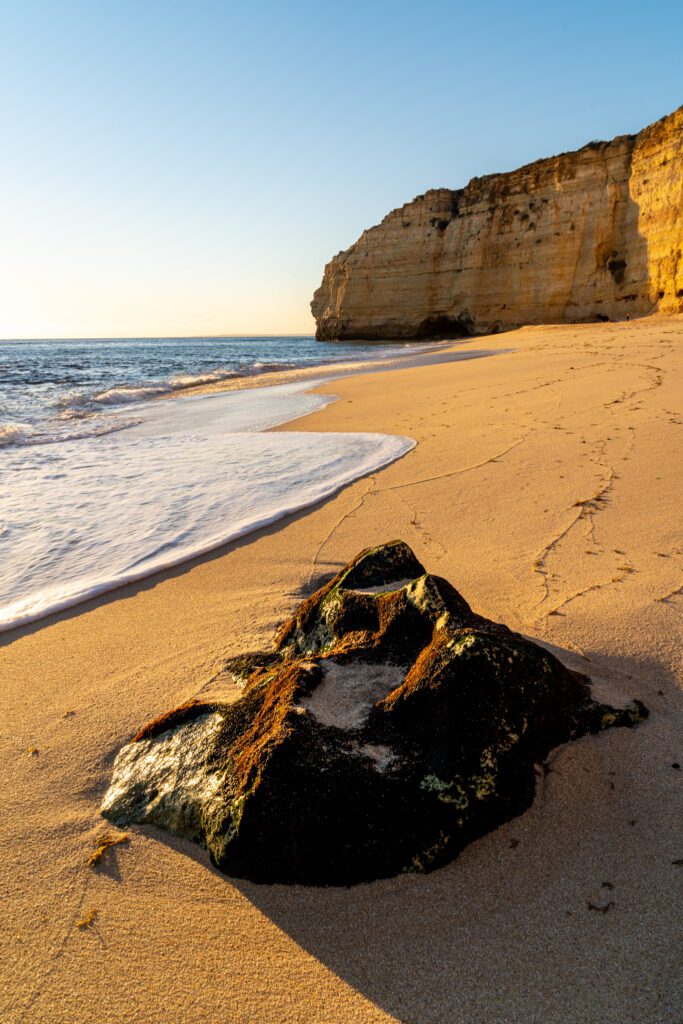
Day 4: Benagil Beach and Caves
On your fourth day, get out on the water and explore the rugged Algarve coastline by boat.
In this case, we’d recommend exploring by kayak because there are a seemingly unlimited number of secret beaches and caves where you’ll be able to actually get out inside the cave, which is not possible on a speed boat trip (at least that I’ve ever seen).
If you’re a beginner in a kayak, we’d also recommend joining a guided tour rather than trying to do it yourself. We love kayaking, but the weather was a bit cold for us, and most companies were shut down for the winter by then. We added it to our list for next time instead.
Which tour you choose depends on where you’re coming from, as there are tours leaving from different points near Benagil Beach, which is just east of Carvoiero.
The easiest way is to do a tour that leaves directly from Benagil Beach (here’s a sunrise tour, which is the best time to be there thanks to calm water and fewer people).
There are also tours that leave from nearby cities like Albufeira or Portimão, or tours with a stand up paddleboard rather than a kayak.
The Headlands West of Carvoiero
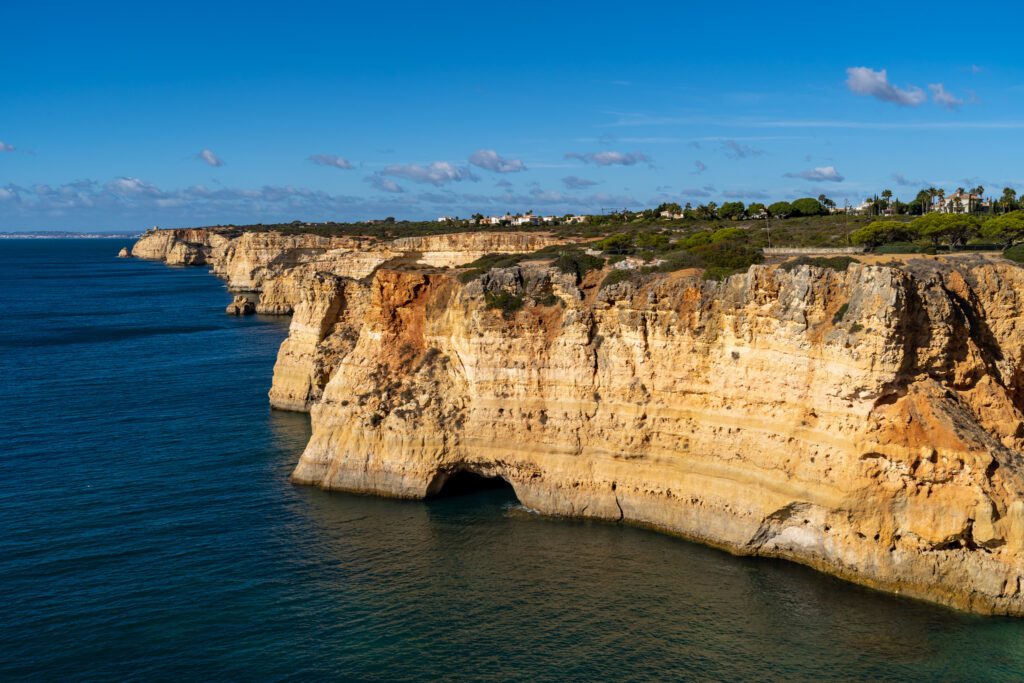
After a break in the afternoon, head back out to explore the beaches and bluffs around Carvoiero. We’re going to give you our favorite points, but be sure to do some exploring and ask around to see if you can discover one or two of your own.
From east to west, here are the spots we enjoyed:
- Praia do Paraíso: Major Greece vibes as you head down the white steps to this small, secluded beach. Lots of steps to get down to the beach, but we think it’s worth it.
- Miradouro da Arriba da Salgadeira: Head out onto the spit for great views along the coast in both directions. It’s very windy.
- Praia dos Caneiros: Beautiful beach with golden sand and shallow, turquoise water that’s far enough from town to mean it’s quieter than other beaches in the area.
- Farol da Ponta do Altar: The lighthouse is fine, but the views over the beaches to the east of the lighthouse are the reason we included this. Walk east from the parking lot along the cliffside until you’re above Praia do Torrado (we couldn’t figure out how to get down to the beach without rock climbing, which we passed on).
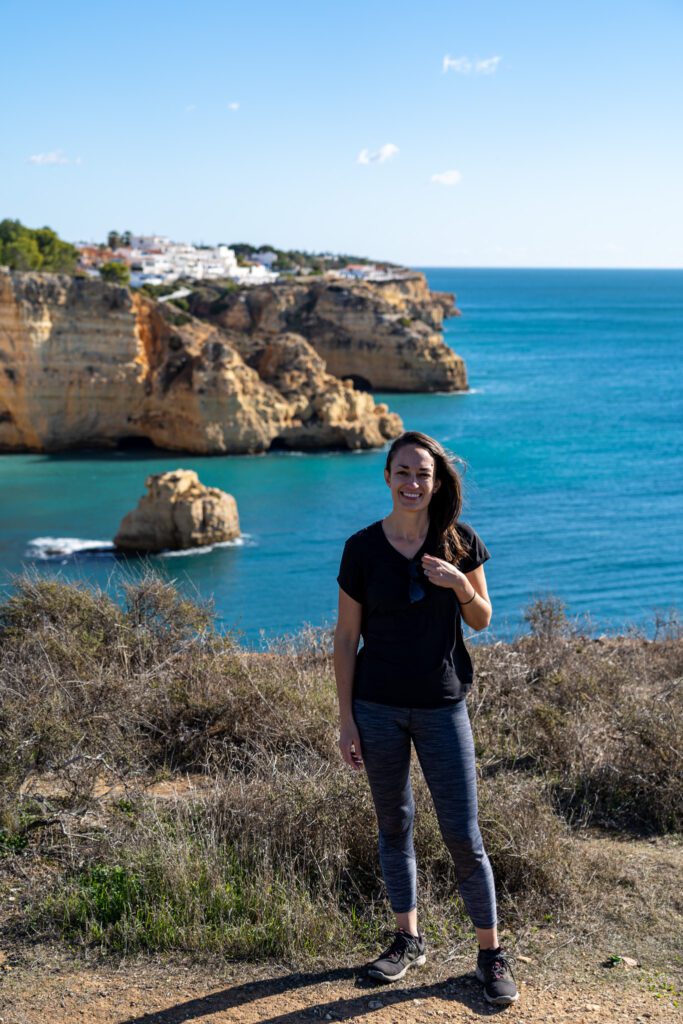
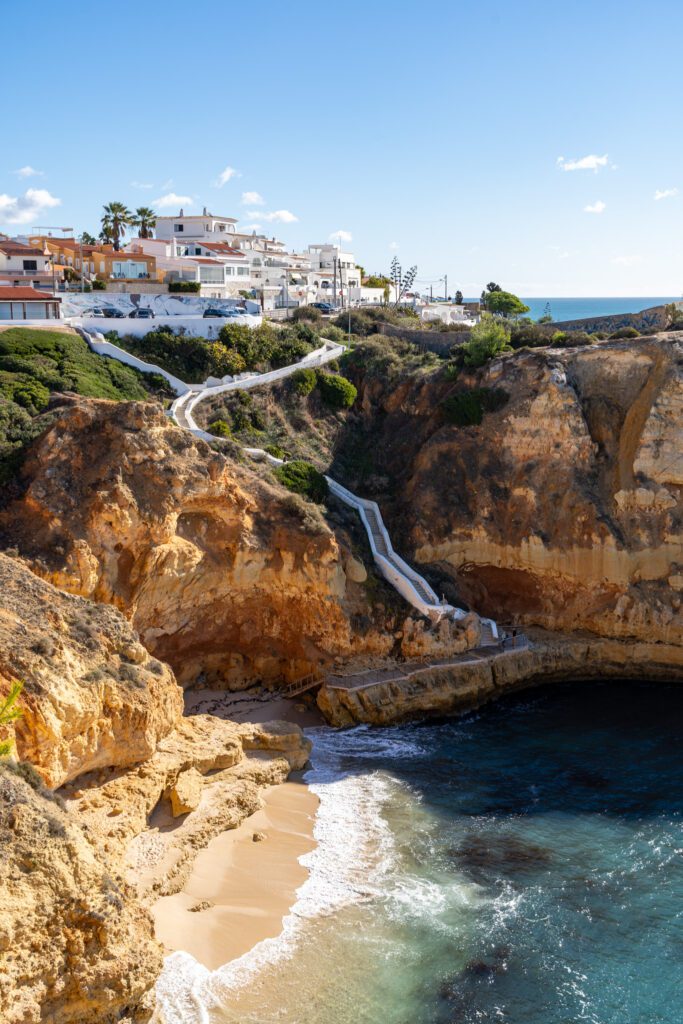
Afterwards, grab dinner in Carvoeiro’s charming downtown area. Another good option is out at Quinta Dos Santos, a lovely winery / brewery / restaurant on a farm 15 minutes outside of town.
You could turn this into a nice loop, starting in town, heading out to each of the beaches, eating dinner at Quinta Dos Santos, and heading back into town.
More Time in the Algarve: Choose Your Own Adventure
Generally, if you have more time on the Algarve, we’d recommend spending it relaxing more rather than trying to do more activities. More beach time and coastal drives rather than planned activities.
However, here are a few specific things we think are worth your time.
Surfing Lessons: I’m not sure there’s a better place in Europe to learn how to surf (or go surfing if, unlike us, you’re already a pro). Unfortunately, winter wasn’t the time for us to try our hands at surfing, but during the warmer months we’d be in.
Albufeira: A charming small town with wide white sand beaches nearby that is worth a full day, if not an overnight. It’s only a half hour by car from Carvoeiro, so it’s an easy day trip. Here’s a guide we liked.
Head to Faro and Tavira: Even further east, you’ll find the charming towns of Olhão, known for its fish market on the water, and Tavira, along with the major city in the region, Faro, which is home to the region’s only airport. We actually spent one night in Tavira, stopping there on our way into Portugal from Seville, and it’s a lovely little riverfront town. The best meal we ate on the Algarve was at O Tonel, in the heart of Tavira’s old town. Don’t miss Ria Formosa Natural Park and Ilha de Tavira, which are both accessible from this stretch of coast.
What to Do with Less Time on the Algarve
If you have fewer days on the Algarve, what you choose to do is going to depend on your interests. For us, we’re not super into just hanging out on the beach, so we’d cut those portions out first and focus on road tripping and hiking along the coast.
However, we also totally understand that you might be super into relaxing on the beach, which is why we’re putting our bias out there for you.
The other thing to consider is where to stay. With 1-3 days on the Algarve, we’d suggest picking just one base and staying there the entire time. We’d recommend Lagos for most people, because it’s a central point between the eastern and western parts of the coast.
However, like we mentioned above, there’s basically an unlimited number of charming little towns littering the Algarve, so Lagos is by no means the only place you could stay and have an enjoyable trip.
With all that being said, here’s how we would spend three days on the Algarve.
What to Do with 3 Days on the Algarve
On your first day, follow “Day 1” as written above.
On your second day, choose between either the Benagil Cave tour by kayak, or hiking the Seven Hanging Valleys Trail.
You could also combine them by doing part of the hike (we’d recommend going from Praia da Marinha to Carvalho Beach), then returning to Benagil Beach to meet a tour (or vice versa, depending on the timing of the tour).
On your last day, follow “Day 2” as written above with a road trip out to the western Algarve and a stop in Sagres to see the southwesternmost point in Europe.
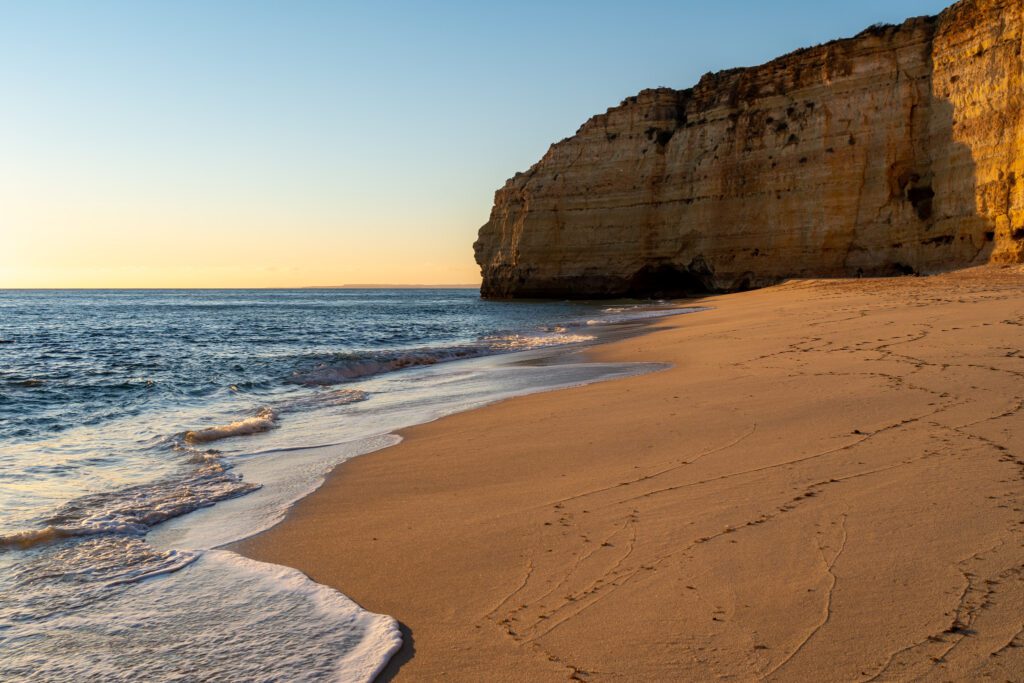
When to Visit the Algarve?
In every single guide, we say something along the lines of “summer is the busiest and hottest time of year – visit in shoulder season instead!”
And, to be clear, that’s probably more true of the Algarve than other places in Portugal (and Europe as a whole).
But, ultimately, it comes down to when you are able to travel. If you have kids, chances are summer is when they have time off school and are able to go on longer trips.
Just know that if you visit the Algarve in the summer, you’re going to experience blistering hot temperatures that make it tough to be out in the sun for more than an hour at a time, and hordes of other tourists flocking to the same tiny seaside fishing villages that, all of a sudden, aren’t nearly as charming.
So when we say “VISIT IN SHOULDER SEASON,” we really mean it. Fall and spring will bring milder temperatures and fewer people – particularly fewer kids and families. If you have the ability to avoid traveling in the summer, we’d strongly recommend it.
We were actually in the Algarve over the winter – at the end of November into the beginning of December – and it was generally lovely. The weather was very mild, though too cold for spending a day on the beach (which isn’t really our thing anyway).
It’s a much more pleasant time to hike the Seven Hanging Valleys Trail, which is more what we’re into.
The other thing to know about visiting in the off-season is that many places will be closed – bars, restaurants, other tourist related services – especially in the smaller beach towns that become very, very sleepy when the tourists go home for the winter.
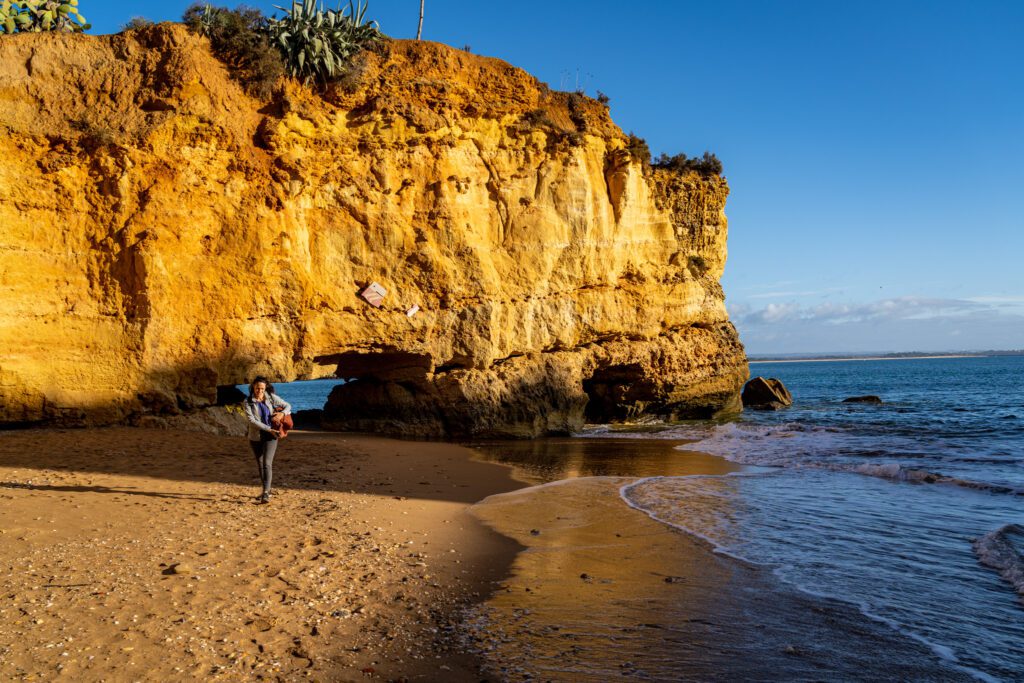
Where to Start and End Your Algarve Road Trip / Getting to the Algarve
There are basically two ways to get to the Algarve that are going to be good for 95% of people, and it largely depends on what the rest of your trip to Portugal looks like. The two options are coming to or from Lisbon (by car or bus/train) or flying directly to the Algarve.
Coming from Lisbon
If your trip starts or ends in Lisbon and you’re going directly to/from Lisbon to the Algarve, then you can rent a car or take a train/bus to make the journey.
We definitely recommend that you rent a car for your Algarve itinerary, and if you’re flying in and out of Lisbon, then it probably makes the most sense to rent a car in Lisbon, drive to the Algarve, and drop the car off back in Lisbon.
However, that proposition becomes a little more expensive if you’re renting the car for a one-way journey thanks to “one-way” rental car fees.
If you’re flying into Lisbon and out of Faro (or the reverse), then it probably makes more sense to train or bus to Lagos or Faro and rent the car from there to avoid the one way fee.
Coming from Elsewhere and Only Visiting the Algarve
If your trip doesn’t involve going anywhere near Lisbon and it’s just a trip to the Algarve, then there’s only one airport that you’ll be able to fly into: Faro Airport.
You can either rent a car from there, which incurs an “airport rental fee” of about 30 Euros, or take a bus or train to Lagos and rent from there.
For what it’s worth, we’d probably just shell out the extra Euros for the airport fee here given the public transit connections between Faro and Lagos aren’t great.
Planning a trip to Portugal?
Here are our other Portugal travel guides to help you plan an incredible trip (even if you have to eat gluten free!).
If there’s no link below, it means we’re still working on it – long, in-depth guides take time! We’re working on it, though, we promise.
Portugal:
- Exactly How to Spend One Week in Portugal (for First Timers)
- 10 Days in Portugal: Planning the Perfect Portugal Itinerary
Lisbon
- 25 Incredible Things to Do in Lisbon: A Complete Guide
- 3 Days in Lisbon: Planning the Perfect Lisbon Itinerary
- One Day in Lisbon: The Best of Lisbon in 24 Hours
- Where to Stay in Lisbon: Our Guide to 4 Amazing Places to Stay
- Gluten Free Lisbon: A Complete Guide to Lisbon’s Best Gluten Free Restaurants
- The Best Coffee in Lisbon: 9 Amazing Lisbon Coffee Shops to Add to Your List
Porto:
- 3 Days in Porto: Planning the Perfect Porto Itinerary
- One Day in Porto: How to See the Best of Porto in a Day
- Where to Stay in Porto, Portugal: The 3 Best Places to Stay
The Algarve:

Thank you so much for this post! Doing my research on the region for my upcoming road trip in Portugal late July… (already worrying about the crowd & heat , and fuel price…), super helpful!!
It will definitely be hot in late July! But I’m sure it will be amazing. Enjoy!